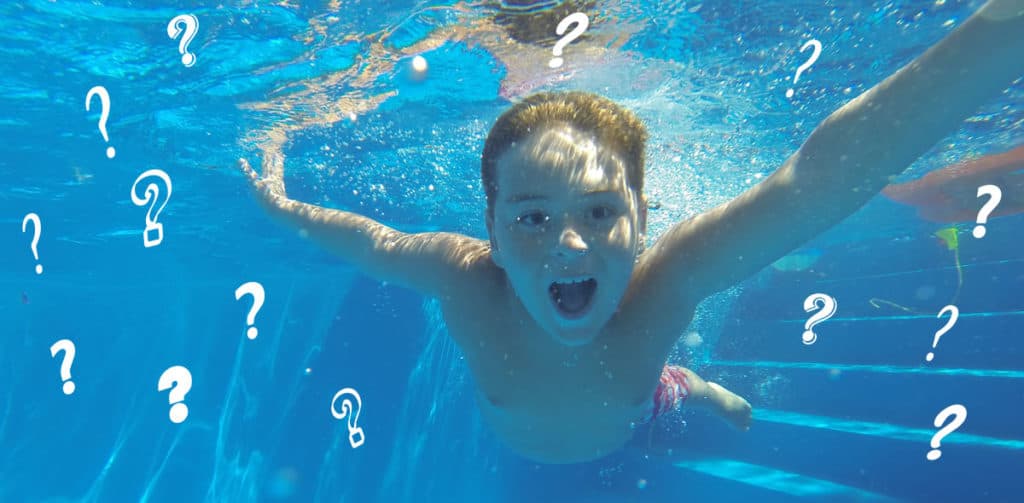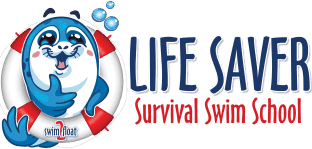
What is SURVIVAL SWIMMING and how is it different from other swimming programs?
This is one of our most frequently asked questions. Survival Swimming has been around for over 50 years. Lessons are based on principles of behavioral science, sensori-motor learning, and developmental milestones. There’s a specific progressions of skills that are taught in a sequence that CONNECTS each separate skill to the next.
Will my child cry or not like water because of lessons?
Yes, your child might cry/fuss/complain. But there is an important difference between being fearful and being apprehensive. You are not yet skilled and are in a new environment with an instructor you don’t know. For children, crying and fussing is primarily how they communicate their unhappiness. This is a new situation, with a new person, and difficult new skills to learn. The crying and fussing does NOT indicate fear unless there has been a previous traumatic water experience. Survival Swimming is not like traditional swim lessons. It is a DROWNING PREVENTION PROGRAM with a specific end goal of your child being able to help themselves in an aquatic emergency. Sometimes, as a parent, you make choices for your child’s safety, like sitting in a car seat, immunizations, etc.. You do this because you know it is in their best interest. SAFETY comes first even if they don’t like it or appreciate it. The same can be said for Survival Swimming. Safety comes first. FUN can be defined as when SKILL meets CHALLENGE. So, once competent in their skills, children cry and fuss less as they gain confidence. After a while many cannot be dragged away from the pool. They cry because they have to leave and are having entirely too much FUN.
Why are lessons 4 days per week and for only 10 minutes?
Their are several reasons for this. First, repetition and consistency are crucial elements of learning for young children. Research shows that short, more frequent lessons result in higher retention. Second, most children have fairly short attention spans. They will not focus on the task for too long and we want to take advantage of the best time for learning. The third reason is that the pool temperature is maintained at 78-88 degrees. This temperature is still lower than your child’s body temperature. Lessons are in the water and therefore their body will be losing body heat. Instructors check students regularly for temperature fatigue since this is often an indicator of physical fatigue.
Why does it take 5-7 weeks for my child to learn this?
The 5-7 weeks is an estimate. This is the estimated time take it takes most children to learn these survival skills. Every child is unique. Life Saver Survival Swim School’s program is specifically designed based on your child’s individual strengths and needs. It’s important to realize that this is an average. Some children will actually finish more quickly while others will need more practice. We are dedicated to safety. Therefore, we want to provide your child with the time and best opportunity to become proficient in his/her survival skills. We will always honor your child’s needs.
I hear you say your priority is survival skills. Will my child learn to actually swim?
Yes! Yes! Yes! At Life Saver Survival Swim School, we believe that part of survival (for a child developmentally ready) is swimming. Children learn the Swim-Float-Swim sequence so that they can get themselves to safety. The difference in our program is that they will learn swimming AND survival skills AND, how to be an aquatic problem solver! It’s a Win-Win!
What is the retention rate with survival swimming lessons?
The retention rate is usually 94-100% for up to one year following lessons. Having said this, children will explore and pick up bad habits by watching other children. Or, they’ll pick up bad habits with interference like floating in a bathtub, or wearing flotation devices. As your child goes through lessons, you’ll learn through communication with your Instructor, what activities may interfere with his/her learned skills. Returning to your instructor for REGULARLY SCHEDULED MAINTENANCE LESSONS is IMPERATIVE to maintaining these skills.
Will my child need additional lessons?
Based on our research, we know that maintenance and refresher lessons are important. Children change so much both cognitively and physically during the first 4-5 years of life. It is important that their water survival skills grow with their bodies. Frequency depends on the child’s age, growth rate, skill level and confidence level. The goal of refresher lessons is to help your child adjust his/her new body size and weight to his/her existing skill level. Your instructor will work with your child to help fine-tune his or her aquatic experience to assist with building efficiency. This will result in new self-confidence. This is especially important if your child has not been able to practice any appropriate aquatic skill between seasons.
Why do you have the children swim in clothes?
Because 86% of children, who fall in the water, do so fully clothed. We want our students to have experience with such a situation. If a child has experienced the sensations of being in the water in clothing, he/she is less likely to experience panic. The child will be able to focus on the task at hand. If you have ever jumped in the water with clothes on, then you know there is a significant difference.
Why should parents enroll their children in Survival Swimming Lessons?
Parents enroll their children because they understand their children’s abilities and want to give them every opportunity to learn. They also feel it’s important to teach their children how to HELP THEMSELVES should they find themselves alone in the water. Research shows that there are better times to learn certain things. Swimming is one of those things and best learned early in life (Newsweek and Drowning Statistics). The Sooner, The Safer.
What other benefits do the students experience?
Every child is unique. However, many parents report that once their young children have mastered learning to swim, the result is much greater self-confidence. This leads to a positive self-concept that is often demonstrated in other aspects of their personalities. There are also obvious health and other psychological gains.
Are swimming lessons for infants and young children safe?
YES! This is another one of our most frequently asked questions. Life Saver Survival Swim School is dedicated to safety and maintaining numerous safety protocols to promote safe lessons. Your child’s health and well-being are our highest priority and are closely monitored on a daily basis. In addition, your child’s medical and developmental history is a mandatory part of the registration process. All of this is held strictly confidential. All instructors undergo an intensive and rigorous training that far exceeds any other training program of this kind. Each instructor is also required to attend a yearly re-certification that includes quality control as well as continuing education. YOUR education in the area of aquatic safety for your entire family is an integral part of your child’s lessons.
What is the American Association of Pediatric's position on swimming lessons for young children?
In May of 2010, the American Association of Pediatrics changed its policy regarding the age at which children may start swimming lessons. Their research shows that swim lessons may actually reduce the drowning risk of children ages 1- to 4-years-old. That study, “Association Between Swimming Lessons and Childhood Drowning” published in the Archives of Pediatric and Adolescent Medicine, March, 2009. It was one of the first studies to probe the relationship between drowning reduction and swimming skills. That study concluded that, “Participation in formal swimming lessons was associated with an 88% reduction in the risk of drowning in the 1- to 4-year-old children…” The AAP encourages parent’s to consider that starting water-survival skills training at an early age must be individualized. It should be based on the child’s frequency of exposure to water, emotional maturity, physical limitations and health concerns.
Why don't parents participate in the water during the lessons?
It takes incredible training, concentration, and objectivity to teach a child how to respond to an aquatic emergency. Our research shows that parents find it too difficult to be objective to be teachers with their own children in the water. Parents get to be the “cheerleaders” and encourage and praise their children in each new skill he/she learns. There will be an appropriate time for parents to get in the water and learn how to properly and effectively work and play with their child.

